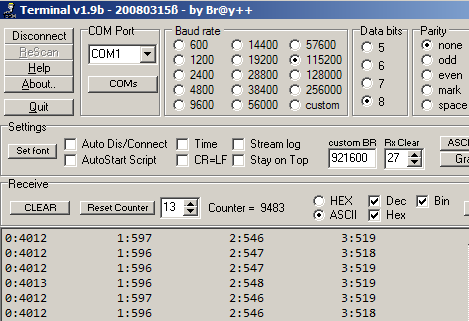en.radzio.dxp.pl
Main menu
Index
Privacy policy
Youtube channel
PCB Manufacturer
Tutorials
STM32F429I-DISCOVERY
STM32VLDISCOVERY
Code library for LCD
S1D15705
SSD1963
SED1335/RA8835
SED1520/NJU6450
SED1530/SPLC501C
KS0108/HD61202
S6B0724
T6963C
ATMEL AVR microcontrollers
HD44780 driver
1-wire driver
Delay utilities
Decoding RC5 infrared
iButton CRC computing
iButton reader
ATtiny2313 board
ATmega162 board
STMicro ST7 microcontrollers
Software I2C impementation
External I2C EEPROM memory
Projects
SPI bus sniffer
I2C bus sniffer
1-wire sniffer
AVR910 programmer
Software
Bitmap converter for LCD
Modbus Master Simulator
Lesson 9. Analog to digital converter (ADC) with Direct Memory Access (DMA)
In lesson 7 I introduce analog to digital converter, that measure voltage on one analog input. For measure voltage on more than one inputs the best way is use DMA for automatic transfer data from ADC to memory. Direct memory access is a mechanism, that allows to transfering data between memories without usage of CPU.
ADC configuration
In comparision to ADC configuration from lesson 7, we must enabled two new modes in ADC peripheral : SCAN mode and DMA mode. Scan mode allows for automatic scanning selected channels without interaction from CPU. After conversion of each channel immediatly starts new conversion of next channel in sequence. We can scan up to 16 regular channels in the sequence. In scan mode there is risk of overwrite data from previous conversion, because all conversion results are stored in this same data register (DR). For this reason in connection with SCAN mode are used DMA mode, that allows for automatic storage of conversion values in data memory after each conversion.
ADC1->CR2 = ADC_CR2_ADON | // turn on ADC |
Configuration of ADC sequencer :
ADC1->SQR1 = ADC_SEQUENCE_LENGTH(3); // four channels in sequence ADC1->SQR3 = ADC_SEQ1(0) | // channel 0 is first in sequence ADC1->SMPR2 = ADC_SAMPLE_TIME0(SAMPLE_TIME_239_5) | // sample time for first channel in sequence |
Variable for storing conversion values :
vu16 AIN[4]; // 4 locations |
DMA configuration
Before we use DMA for transferring data between two areas of memory space of STM32 microcontroller, we have to say to DMA peripheral some informations, like as : source address (data register of ADC), destination address (table for conversions results), number of transfers (amount of scanned input channels).
DMA1_Channel1->CPAR = (uint32_t)(&(ADC1->DR)); // peripheral (source) address DMA1_Channel1->CCR |= DMA_CCR1_CIRC | // circular mode enable DMA1_Channel1->CCR |= DMA_CCR1_EN ; // Enable channel |
Sending conversion results
For sending result we use code from lesson 8.
do{ |
Complete source code :
//============================================================================= #define USART_TX_GPIO GPIOA #if (USART_RX_PIN > 7) #if (USART_TX_PIN > 7) GPIOA->CRL = (GPIOA->CRL & 0xFFFF0000) | ADC1->CR2 = ADC_CR2_ADON | // turn on ADC ADC1->CR1 = ADC_CR1_SCAN; // enable scan mode ADC1->SQR1 = ADC_SEQUENCE_LENGTH(3); // four channels in sequence ADC1->SQR3 = ADC_SEQ1(0) | // channel 0 is first in sequence ADC1->SMPR2 = ADC_SAMPLE_TIME0(SAMPLE_TIME_239_5) | // sample time for first channel in sequence DMA1_Channel1->CPAR = (uint32_t)(&(ADC1->DR)); // peripheral (source) address DMA1_Channel1->CCR |= DMA_CCR1_CIRC | // circular mode enable DMA1_Channel1->CCR |= DMA_CCR1_EN ; // Enable channel ADC1->CR2 |= ADC_CR2_ADON; // Turn on conversion USART1->CR1 = USART_CR1_UE | USART_CR1_TE; USART_PutString("STM32VLDISCOVERY tutorial lesson 9\r"); do{ } |
Results on terminal :
